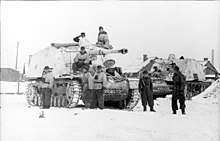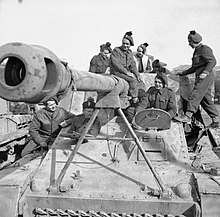Nashorn
Nashorn (German "rhinoceros", pronounced [ˈnaːsˌhɔɐ̯n] ("nahss-horn"), without the "sch"-sound), initially known as Hornisse (German "hornet"), was a German tank destroyer of World War II. It was developed as an interim solution in 1942 by equipping a light turretless chassis with the Pak 43 heavy anti-tank gun. Though only lightly armoured and displaying a high profile, it could frontally penetrate any Allied tank at long range, and its relatively low cost and superior mobility to heavier vehicles ensured it remained in production until the war's end.
| Sd.Kfz. 164 Nashorn | |
|---|---|
.jpg) A Nashorn tank destroyer on display at "Park Patriot" military museum in Moscow, Russia | |
| Type | Tank destroyer |
| Place of origin | Nazi Germany |
| Production history | |
| Designer | Alkett |
| Manufacturer | Alkett, Deutsche Eisenwerke |
| No. built | 473 |
| Specifications | |
| Mass | 24 tonnes (52,910 lbs) |
| Length | 8.44 m (27 ft 8 in) with gun |
| Width | 2.95 m (9 ft 8 in) |
| Height | 2.65 m (8 ft 8 in) |
| Crew | 5 |
| Armor | hull: 20–30 mm (0.78–1.18 in) superstructure: 10 mm (0.39 in) |
Main armament | 88 mm (3.46 in) Pak 43/1 gun |
Secondary armament | 7.92 mm machine gun (carried inside) |
| Engine | Maybach HL120 TRM 11.9 litre V-12 gasoline engine 296 hp (300 PS, 221 kW) |
| Power/weight | 12.3 hp/tonne |
| Suspension | leaf spring |
Operational range | 235 km (146 mi) |
| Maximum speed | 42 km/h (26.71 mph) |
Development


After the first German experiences with the newer Soviet tanks like the T-34 or the Kliment Voroshilov tank during Operation Barbarossa, the need for a Panzerjäger capable of destroying these more heavily armoured tanks became clear.
In February 1942, the Alkett (Altmärkische Kettenwerke GmbH) arms firm of Berlin designed a tank destroyer using their recently developed Geschützwagen III/IV which as its name indicated used components of both the Panzer III and Panzer IV tank. The 8,8 cm Panzerjägerkanone 43/1 L/71[1][2] (or shortly Pak 43/1), a long-barreled anti-tank gun more known as the main armament of the Tiger II, was mounted on the rear of the chassis complete with its gun shield and an open-topped superstructure was built up around the gun to give the crew some protection. The gun had the same traverse and elevation as if it had been on its carriage: 15° to either side and between -5° to +15° elevation. To accommodate the long and heavy gun, the hull had to be lengthened and the engine moved from the rear to the centre of the chassis. The amount of armour provided for the crew compartment was limited. The shielding provided was adequate to protect the crew from blast and small arms, but not armour piercing rounds. Thus, like the Marder series weapons, the vehicle was not intended to engage in tank fights, but to provide mobility to a powerful anti-tank gun.
This model was presented for approval to Adolf Hitler in October 1942 and entered production in early 1943. It had numerous official designations, such as 8,8 cm Pak 43 (L/71) auf Fahrgestell Panzerkampfwagen III/IV (Sf) or 8,8cm Pak43 (L/71) auf Geschützwagen III/IV (Sd. Kfz. 164), though it was also known as the Panzerjäger Hornisse (in English "Tank-hunter Hornet")
During the first half of 1943, a new model of the Hornisse was introduced into production. This model altered the driver's front armour plate, along with other minor differences. This model and its predecessor, the few early production vehicles, were almost indistinguishable. It was renamed Nashorn by Hitler in 1944.
Total production of the Nashorn amounted to some 494 vehicles, most of which were built in 1943. In January 1944, Hitler favored production of a newer, fully-casemated tank destroyer, the Jagdpanzer IV, which had a much lower silhouette, thicker frontal armor (60 mm frontal plate), and an effective though less powerful 7.5 cm gun. Though still primarily an ambush weapon, this vehicle was better built for armoured engagements. Production of the Nashorn continued into 1945, although at a slow pace.
Combat service
%2C_Panzerj%C3%A4ger_Nashorn-Hornisse.jpg)

The Hornisse/Nashorn was issued to the heavy anti-tank battalions (Schwere Panzerjäger-Abteilungen), with which six would eventually be equipped: Schwere Panzerjäger Abteilung 560, 655, 525, 93, 519 and 88. Each battalion was equipped with 45 Nashorns. Most of the Nashorns in these units fought either on the Eastern Front or in Italy, few having been sent to Western Europe.
The Nashorn's gun was a variant of the Pak 43, one of the most effective anti-tank guns deployed during the war and closely related to guns used later for the Ferdinand/Elefant, Tiger II and Jagdpanther. Its tungsten carbide–cored round, the Pzgr. 40/43, was capable of penetrating 190 mm of rolled steel armour at a 30° angle of impact at a distance of 1,000 m. The gun's performance enabled Nashorns to penetrate the front armour plating of any Allied combat vehicle and to engage enemy units while staying out of range themselves, thanks to its combination of excellent gunsights and optics and the highly-accurate gun.
The Hornisse/Nashorn made its debut during the Battle of Kursk in 1943, where it performed extremely well. The ability to engage the enemy at long distances negated the disadvantages of its light armour, lack of a roof and a large profile, and revealed that the weapon was well suited to the open and flat steppes that make up much of the landscape of what was then the western Soviet Union. In Italy, however, the generally hilly terrain was not as favourable to the harnessing of the Nashorn's full ability at accurate long-range fire against enemy forces as in Russia.
An Iosif Stalin 2 from the 72nd Independent Guards Heavy Tank Regiment on May 1, 1944 in Khotymyr was lost after long-range fire from a German Nashorn tank destroyer disabled the heavy tank at a range of 2600m frontally.
On 6 March 1945, a US Army M26 Pershing heavy tank was knocked out by a Nashorn in the town of Niehl near Cologne, at a close range of under 300 yd (270 m).[3]
Survivors
There are two Nashorns on display in military museums: one in the United States Army Ordnance Museum (permanently closed and the vehicle transferred out to Fort Lee) and at the new Patriot Park military museum in Moscow, Russia (it was formerly on display in Kubinka Tank Museum). A third privately owned Nashorn is being restored to running condition in the Netherlands. In 2019, this third surviving vehicle suffered severe damage after being caught in an accidental garage fire, with both the transmission system and engine getting the worst of it. It is now awaiting public donations for its repairs and overhaul.
The restoration of the Nashorn is going well and it’s driving again.[4][5]
Armor
| Thickness/slope | ||||
|---|---|---|---|---|
| Front | Side | Rear | Top/Bottom | |
| Turret/Gun Shield | 10–15 mm (0.39–0.59 in)/30°[6] | open | ||
| Superstructure | 15 mm (0.59 in)/30° | 10 mm (0.39 in)/15° | 10 mm (0.39 in)/10° | 10 mm (0.39 in) |
| Hull | 30 mm (1.2 in)/12° | 20 mm (0.79 in)/0° | 20 mm (0.79 in)/21° | 15 mm (0.59 in) |
Technical data
- Manufacturer: Deutsche-Eisenwerke AG, in Teplitz-Schönau
- Crew: 4 or 5
- Combat weight: 24 metric tons
- Dimensions
- Length (with gun): 8.44 m
- Length (without gun): 6.20 m
- Width: 2.95 m, 3.176 m with 'Ostketten' tracks
- Height: 2.65 m
- Ground clearance: 0.4 m
- Road speed: 42 km/h
- Road range: 235 km
- Tracks: 61/400/120 kg
- Type: single pin
- Width: 400 mm
- Ground contact length: 3.80 m
- Shoes(links)/track: 104
- Ground pressure: 0.85 kg/cm²
- Suspension: leaf spring
- Shock absorbers: no
- Vertical obstacle: 0.6 m
- Trench: 2.3 m
- Fording: 0.8 m
- Engine: Maybach HL 120 TRM Ausf. A
- Type: V-12 60 deg
- Horsepower: 300 PS @ 3000 rpm
- Displacement: 11,867 l
- Compression ratio: 6.2-6.5:1
- Fuel: gasoline
- Fuel consumption (road): 2 l/km
- Fuel capacity: 470 l (two fuel tanks)
- Transmission: ZF (Zahnradfabrik Friedrichshafen AG) SSG 77 Aphon
- Type: synchromesh manual
- Gears: 6/1
- Steering: Daimler-Benz/Wilson clutch/brake
- Clutch: Fichtel & Sachs La 120 HDA dry, triple disc
- Armament
- Main gun: 88 mm Pak 43/1
- Type: Anti-tank gun
- Caliber: 88 mm
- Barrel length: 71 calibers
- Breech: semiautomatic, horizontal sliding-block
- Traverse: manual, +/-15°
- Elevation: manual, +20/-5°
- Rounds carried: 24 to 40
- one 7.92 × 57 mm MG-34 or MG-42 machine-gun carried inside the vehicle
- appr. 600 rounds
- Primary gun sight: Sfl. Z. F. 1a (Selbstfahrlafetten-Zielfernrohr)
- Magnification: 5×
- Field of view: 8°
- Indirect fire sight: Aushilfsrichtmittel 38
- Magnification: 3×
- Field of view: 10°
- Radio: FuG Spr. f
References
- D 2030 – 8,8 cm Panzerjägerkanone 43/2 (L/71), Beschreibung, 28.1.1944. Berlin.
- D97/1+ Gerätliste, Oberkommando des Heeres Heereswaffenamt, s.45, Berlin 1.7.43
- Youtube video by Mark Felton Productions - https://www.youtube.com/watch?v=MRDnJ-_Kbk8
- https://nl-nl.facebook.com/Nashorn.SD.KFZ.164.restauration/
- https://www.youtube.com/channel/UCfAA4BgO3pqk4ikjL7m4xUA
- 15mm after May 1943
External links
- Achtung Panzer!-Nashorn Page
- World War II Vehicles
- Hornisse manual
- Nashorn in Kubinka tank museum
- Armour penetration table of 8.8 cm Pak 43
- Surviving Panzer IV variants - A PDF file presenting the Panzer IV variants (Jagdpanzer IV, Hummel, Nashorn, Brummbär, StuG IV, Flakpanzer tanks and prototypes based on Pz IV) still existing in the world
- Nashorn undergoing restoration